The stage is empty. So are the bleachers extending along one of the city’s main streets. It is four o’clock on a Saturday afternoon. The thermometer reads 38° C, smoke from fires has swarmed the horizon and it hurts to breathe the dry air. If not for a man wearing a green and yellow shirt and some shop windows decorated in the colors of the Brazilian flag, it would be hard to tell that we are in Sinop, an agribusiness capital and one of the most important cities for the far-right in Mato Grosso, on an emblematic day: September 7, Independence Day in Brazil. It is when the military holds demonstrations in the streets, but the parade, scheduled for 4:30 PM, has just been canceled due to “high temperatures, low air humidity, and severe drought,” says the municipal government. It was canceled because of the climate. A climate that is increasingly off kilter because of the forest’s destruction.
It doesn’t seem like it, but Sinop is in the Amazon. Founded by members of the military in 1974, one of the harshest years in Brazil’s business-military dictatorship. A result of the regime’s policy of “occupation” under the slogan of integrating to avoid surrendering to foreign interests, it forged municipalities with imaginary enemies in the middle of the forest. Its name is symbolic: made up of the initials of Sociedade Imobiliária Norte do Paraná (loosely translated, the Northwest Property Society of Paraná, now the Sinop Group), the colonizer enterprise that purchased the so-called Celeste parcel, built the first streets, and began construction. And consolidated it as well: part of the land that formed the city is stolen public property, acquired through land-grabbing, like much of the land in the Amazon, as per a Federal Police report attached to a lawsuit.
Just half a century ago, everything there was forest. Now, 156,000 hectares of farmland have been opened up in the municipality of 216,000 people, with no differentiation between rural or urban areas, wealthy or poor neighborhoods. The ground is marked by the dried and twisted roots from the last corn stalks of the season, a crop planted in the off-season for soybeans, a legume that from October to April brings a toxic smell to the air, the residents say. The horizon in the rural area is overrun with towering silos. In 2022, the city had the highest Domestic Gross Product in Agribusiness in Mato Grosso. And its per capita GDP was almost the same as the city of São Paulo in 2021.
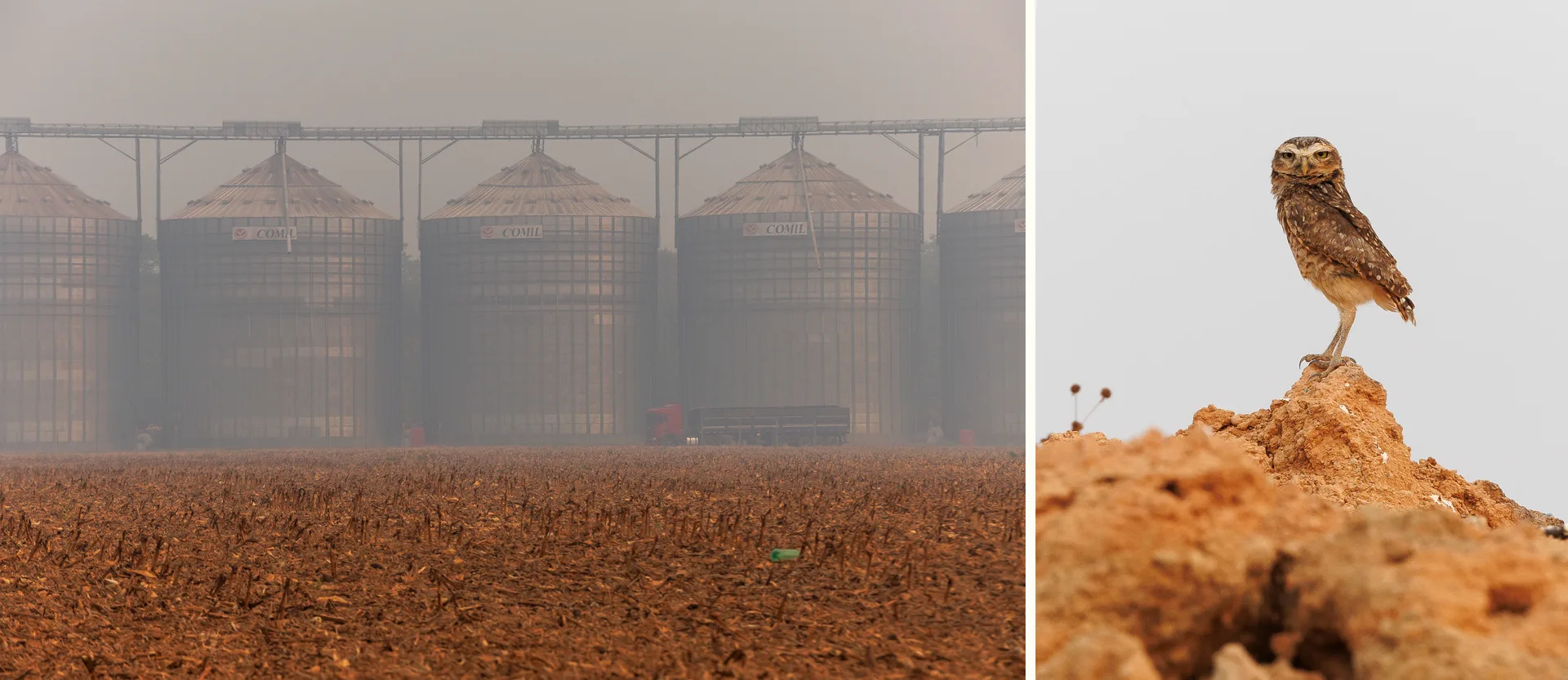
In the rural area, barriers of silos dot the landscape, as do burrowing owls, who usually appear at dusk
Sinop is the business-military dictatorship plan that thrived. And it became a symbol of how the agrarian far-right operates in the country. A good number of the people who assaulted democracy on January 8, 2023, came from this region, according to a UOL survey, attempting to topple the government of the recently-elected Luiz Inácio Lula da Silva (Workers’ Party) to keep Jair Bolsonaro (Liberal Party) in power. And in the first municipal election after the attempted coup, its political elite is dueling to see who will capitalize on the extremism.
If in the last election, in 2020, there were six candidates running for mayor from across the political spectrum, including one Workers’ Party candidate, this year only two are vying for the mayorship. Mayor Roberto Dorner (Liberal Party), who is running for reelection, and Mirtes Grotta da Transterra (New Party). Both are monied executives: he owns a TV network, the city’s local SBT Network affiliate; she is from the family that owns Transterra, one of the municipality’s biggest construction companies.
Not only are they fighting for Bolsonaro’s support, but both have taken part in or have families connected to the movement to question the election results that made Lula Brazil’s president in 2022. Dorner took part in far-right protests after the election, in late October, that closed the BR-163 highway in Sinop. While Mirtes’ husband, Rogério Grotta, and her daughter Luane were accused by the Federal Prosecutor General of having taken part in January 8 actions in Brasília.
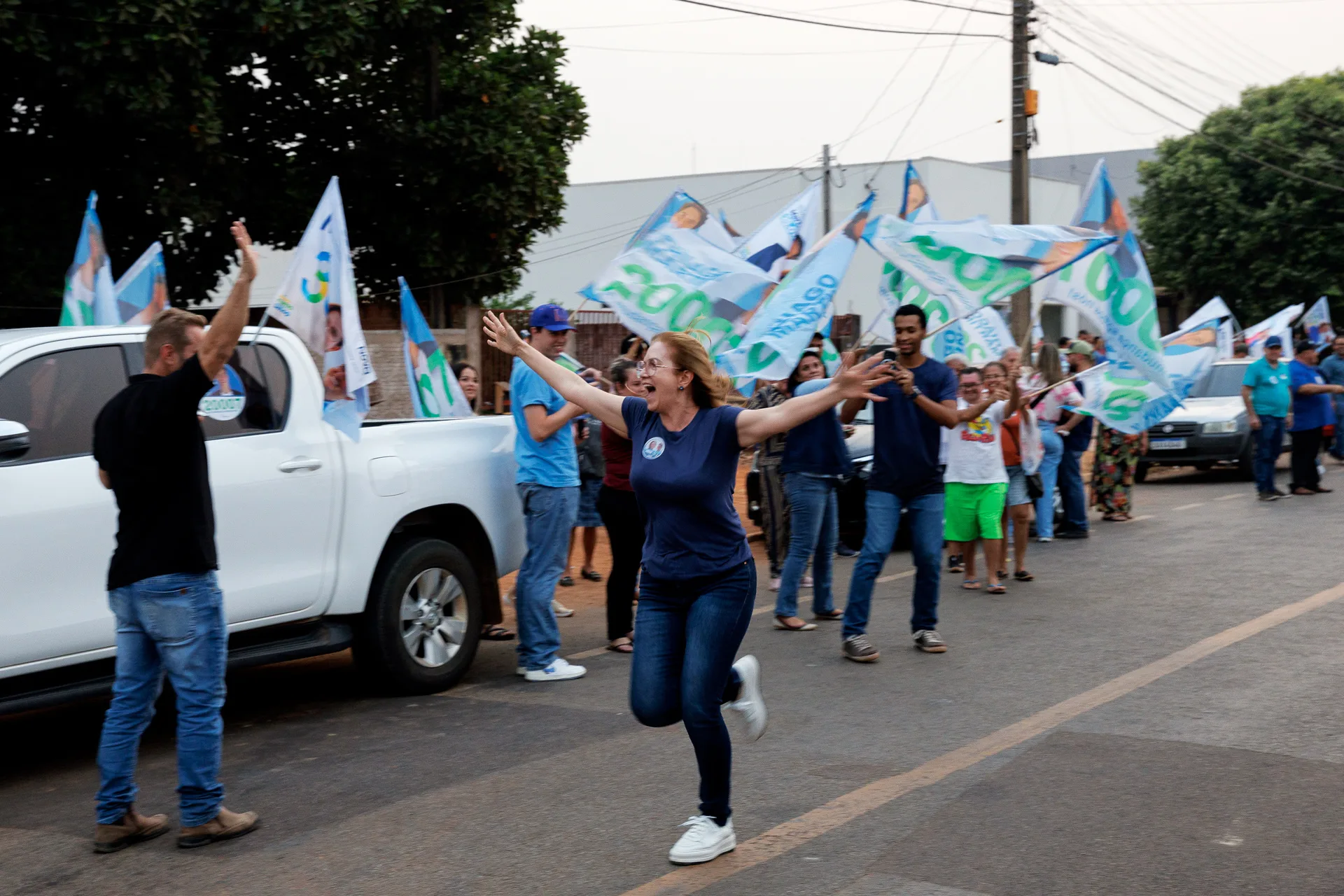
Family members of Bolsonaro-backed candidate Mirtes da Transterra (New Party) were involved in acts to overthrow the government on January 8
And the political elite’s support for the overthrow of the government doesn’t stop there. The president of Mirtes’ party in Sinop, Antonio Galvan, is the former president of the Brazilian Association of Soybean Growers, he is the “general” of the so-called Green and Yellow Brazil Movement, and he is named in a report from the Brazilian Intelligence Agency, obtained by O Globo newspaper, as one of the main organizers of acts to overthrow the government. The soy grower was recently indicted by the Federal Police for actions on September 7, 2021, when protesters were in Brasília asking for Federal Supreme Court justices to be impeached. Contacted through his attorney, Galvan had no comment.
Rosana Martinelli (Liberal Party), the former mayor of Sinop who is currently filling a temporary seat in the Senate, is also under investigation for suspected participation in January 8 acts and she has had her passport withheld. She denies participating, even though she admits she was at protests that happened in Sinop.
Early this September, unlike the smoke, the campaign had yet to be seen on the city’s streets, except for a few stickers on cars and trucks. “Just as the Teles Pires River appears calm, but at its deeper layers there are turbulent waters, we have a similar scenario in Sinop,” says João Carlos Silva, a young 32-year-old man with a degree in Agroecology who has been closely following the city’s disputes over politics and land. He speaks slowly. He has long curly hair and a light-colored and neatly trimmed beard with some gray hairs. João is referring to the river of greenish-brown water that runs through a rare corridor of preserved forest some 18 kilometers from the city center. He tries to sum up the musical chairs that was the subject of intense reporting by local newspapers in March and April of this year. “Everyone was wanting to surf on national policy and gain Bolsonaro’s backing.”
Mayor Dorner was a member of the Republicans, his party when he was elected four years earlier, but he switched following an invitation from the Liberal Party’s national president, Valdemar Costa Neto. “But they forgot to let everyone know, and everyone was the municipal Liberal Party,” says João. “And that everyone was speaking very clearly to Jair [Bolsonaro]”. In addition to Rosana Martinelli, the former mayor, Mirtes was also a member of Sinop’s Liberal Party – both stated their opposition to Dorner. When Dorner came to the Liberal Party, Mirtes moved over to the New Party. And she got formal support from Bolsonaro at a rally that filled one of the city’s squares in April of this year, which left the mayor in a “humiliating” situation, according to an article in the Diário de Cuiabá. He again tried to get closer to the retired army captain while he was visiting the city – but he was solemnly ignored by the former president. Mirtes seized the moment and publicized the meeting. In the end she was ordered to remove the posts from her social media after Mato Grosso’s Regional Electoral Court considered it to be early campaigning.
At the end of the day, the candidate from Bolsonaro’s party was unable to gain his support. Yet even without this important electoral leader, Roberto Dorner has proven to be the favorite in the race.
There are many particularities to the city beyond politics. Sinop has, for instance, farmland within its urban area, in both high- and low-income areas. There are six-meter-long trucks with super-extended side-view mirrors, a kiosk in the mall that sells grilling knives for R$ 3,999, and criminal gangs who steal agrochemicals. Although the city deforested 205,000 hectares of forest from 1987 to 2023 (equal to more than half of its total area, or nearly twice the size of the city of Rio de Janeiro), according to Mapbiomas, red-and-green macaws and blue-and-yellow macaws can still regularly be seen along its streets. In the late afternoon, especially in the rural area, there are numerous burrowing owls.
According to biologist and primatologist Gustavo Canale, Sinop lies in the world’s largest tropical ecotone (a transition area between two biomes, between the Amazon and the Cerrado in this case). “And this uniqueness means the region has the greatest diversity of monkeys on the planet,” says the gray-haired researcher from the Federal University of Mato Grosso. “And seven species, including the red-bearded titi monkey, that only live in this region are being threatened by the advance of agribusiness into tropical areas.”
If early on in its existence, back in the days of the dictatorship, the priests blessed each new development built, to this day the city still maintains a culture where “progress” is what is good – and “progress” will only be possible without a forest. In the 1990s, it was the timber companies that controlled the region’s economy. When the timber was all gone, soybeans came, starting in the 2000s. Despite the disdain for the forest, the altar at Sacred Heart of Jesus Cathedral has a mural of Christ surrounded by lush chestnut trees and a preserved forest. Its streets are named after trees: Sibipirunas Avenue, Acacias Avenue, and Sapucaias Street. There are swanky shops, planned thoroughfares, large roundabouts, few stoplights and elaborately-landscaped medians. Yet many of its squares are arid, filled with palm trees that provide hardly any shade. Beyond the forest park and botanical gardens, the shadiest area in the city is the cemetery.

Sinop is the business-military dictatorship plan that “thrived,” based on destroying the forest, first with logging activity and now with soy
Sinop is also an electoral stronghold of ruralists with national profiles. Nilson Leitão, a member of the Social Democratic Party of Mato Grosso, is one – he was the city’s mayor from 2001 to 2008, before being elected to Brazil’s lower house of Congress in 2010, and now he is the president of the Pensar Agropecuária Institute, an organization financed by large agribusiness companies that backs the Agricultural Parliamentary Front in Brazil’s legislative branch. Leitão is trying to help Mirtes launch her campaign.
“It’s Valdemar Costa Neto’s candidate against Bolsonaro’s candidate. It seems easy, it seems uniform, but we have a significant number of workers who didn’t vote for Bolsonaro,” João recalls. He is referring to the 23% of the city that went for Lula in run-off voting – and that this year has no alternative in the mayoral race.
A cornered opposition
While council member Graciele Marques dos Santos (Workers’ Party) is speaking on the dais of the Municipal Chamber, her workmates are chatting, looking at their phones, and sending messages. “This has been a very sad week for us because, everywhere we look, we are seized by smoke, by soot, as a result of the fires.” The city’s only woman and only leftist on the municipal council, she speaks firmly, but there is a tone of sadness in her voice: “A scene from a horror movie. I’ve asked myself how far human greed goes. Even the forest park caught fire, animals died there, under our eyes, in the city’s center. This is pitiful. We are digging our own grave.”

The only woman and left-wing representative in the Municipal Chamber, Graciele Marques (Workers’ Party), is ignored by her colleagues while she criticizes the fires
Graciele pays dearly for being part of two “minorities” in the ag capital. “Every time I say something about the climate issue, my words are twisted. The last time I talked about the forest park, they said I disparaged the Fire Department. What I said here is recorded, I didn’t even mention the Fire Department at that time.” At the end of her ten-minute speech she demands the municipal government take measures to contain the fires. Her colleagues continue chatting and sending messages on their phones.
Twisted words are “the least” of what has happened to the council member since she began serving her first term, four years ago. “When I was sworn in, in the first month, the attacks started, so it was only downhill from there… until today.” She recalls when they took a chainsaw to a billboard the social movements had put up in the city criticizing the Bolsonaro administration, in May 2021. When they called her a “bitch” and a “miserable woman” on the street. Or when she was threatened on social media. She also remembers October 2022, when the BR-163 highway was overtaken by people protesting Lula’s victory and when they released fake news that she had drafted a bill to remove the protestors from where they were. “I didn’t sleep for a week.”
With the attacks and harassment, she began to take unprecedented measures: she began avoiding walking on the street alone, she changed routes, she stopped taking her car to the mechanic. “You no longer have privacy, you don’t have a personal life… it’s not just being on the left, it’s the question of criticizing agribusiness, it’s the question of defending environmental issues, defending the LGBTQIA+ population. They have an inexplicable hatred of this,” she says. “A lot of people saw what happened to me, the threats and intimidation, and it discourages candidates from running,” Graciele says, adding that the Workers’ Party had even started to articulate a mayoral candidate, but backed down because of the slim chances of winning. Out of this year’s 208 aspiring council members, only 39 are from leftist parties (11 from the Workers’ Party coalition, 11 from the Democratic Labor Party, and 17 from the Brazilian Socialist Party).
Political scientist Camila Rocha, who has studied the far-right and done research in the field among Mato Grosso’s soybean farmers, says agribusiness has always been very close to right-wing parties. Yet the connection with the far-right – represented by Bolsonaro – initially happened because of the historic connection between Brazilian military ideology and agricultural activity. “The military dictatorship’s imagination of Amazonian occupation and of occupying lands considered to be ’empty,’ ignoring the presence of Indigenous and Quilombola people, has to do with the concept of development connected in particular to agriculture, among other economic activities. And this idea of the dictatorship reappears more forcefully under the administration of Bolsonaro [a captain in the Army],” says the researcher with the Brazilian Center for Analysis and Planning and the author of the book Menos Marx, Mais Mises (Less Marx, More Mises, loosely translated).
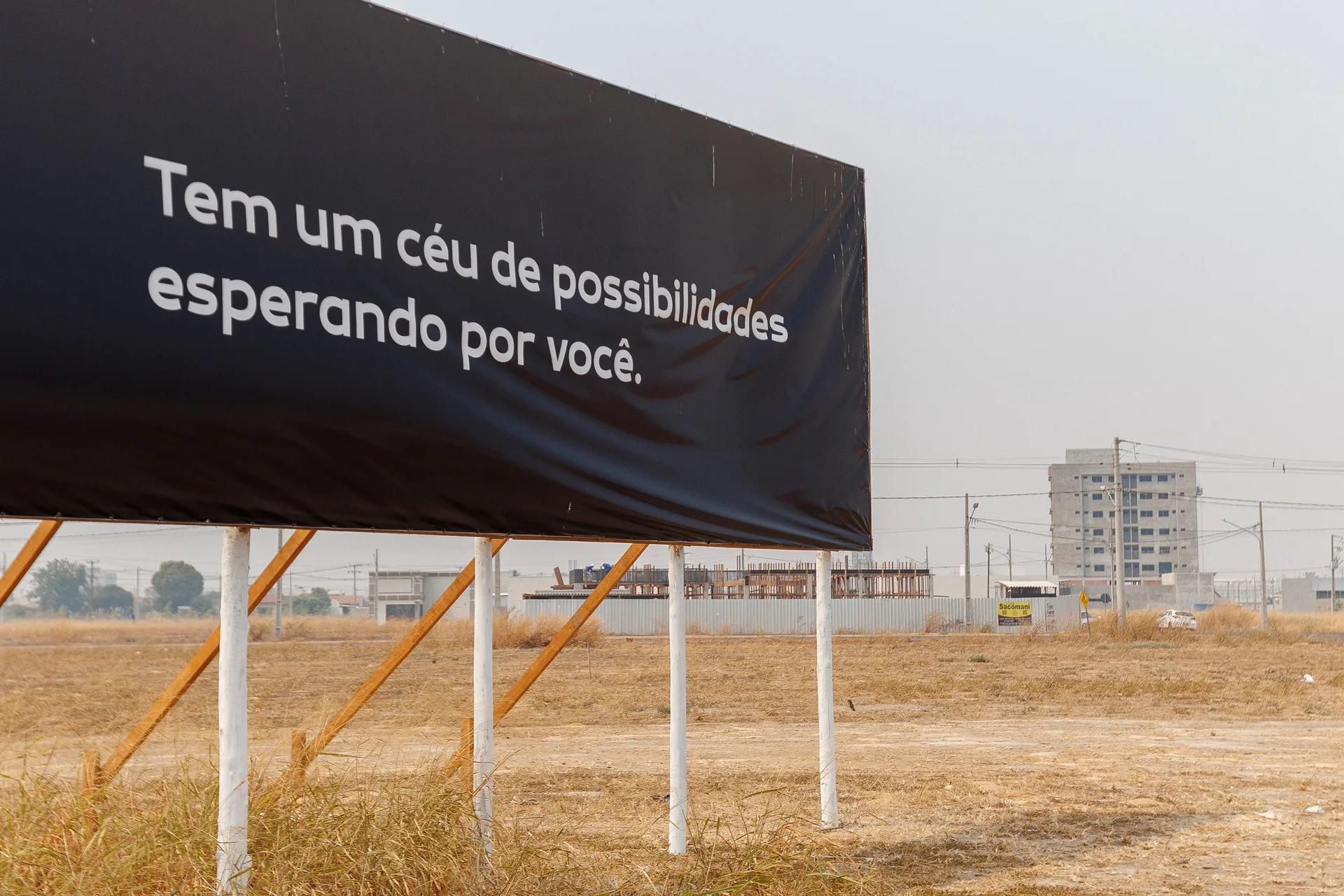
In mid-September, the sky over Sinop and part of Mato Grosso was overtaken by smoke from fires
Secondly, Camila continues, during the Bolsonaro administration there is an intention to exceed constitutional limits, (such as through the historic cut-off point bill, which posits that Indigenous people are only entitled to their land if they were occupying it at the time of the Constitution’s enactment, or the gutting of environmental enforcement), which ends up favoring agribusiness by advancing the borders of farmland and providing access to lands that had up to that point been inaccessible. “There is still this feeling where some in ag feel free to do illegal or criminal things and know they won’t be punished for it,” she adds.
It is important to keep in mind that Brazilian agribusiness is heterogeneous. It is comprised of various sectors and representative entities, which range from the so-called “denialists” (the furthest to the right), to more moderate groups (advocating reduced deforestation and policies to grow a low-carbon economy), as researcher Caio Pompeia explains in his paper on The currents of agribusiness during the Bolsonaro government: divergences and agreements concerning socio-environmental issues. In Brazil’s Center-West, there is a more extreme group of soybean farmers, primarily gathered around the Association of Soybean and Corn Producers of Mato Grosso, led up until 2020 by Galvan, the president of the New Party in Sinop.
The organization had started to grow closer ties to Bolsonaro in 2016, says Caio, and this intensified in 2017, after the Federal Supreme Court found that the constitution upholds federal government enforcement of back-payments from rural employers to the Rural Worker Aid Fund – a tax that defrays some of the retirement costs for field workers.
“It was in connection with groups that did not agree with the Rural Worker Aid Fund back-payments that the presidential candidacy of then-federal deputy Jair Bolsonaro gained steam in rural media,” Caio writes in an article published in Piauí magazine. And the main defenders of forgiving these back-payments was Nabhan Garcia, with the Democratic Association of Ruralists, and Galvan, who years later would become the president of the Brazilian Association of Soybean Growers. Both became fundamental bases of support for Bolsonaro’s candidacy and, later, of his administration’s mismanagement. Nabhan became Secretary of Land Affairs and Galvan was the leader of the Green and Yellow Brazil Movement, which funded and organized several anti-democratic protests in support of the former extreme right-wing president.
The Bolsonaro administration then made good on its promise: “he passed a drove of anti-environmental” measures that benefited agribusiness, especially regarding land issues. Nabhan suspended agrarian reform, Bolsonaro prohibited demarcation of Indigenous Territories. In the opinion of geographer and researcher Warllen Torres Nannini, there is an immediate benefit for the agricultural sectors. “The criminal increase in the degradation of natural resources and the advance of agribusiness over Brazilian biomes are some of the side-effects of the anti-environmental policy put into practice by Bolsonaro’s political agenda, with a package of flexibilizations and decrees, it incentivized and, at the same time, rewarded lawbreakers who promoted the systematic increase in deforestation and land-grabbing in the country,” he writes.
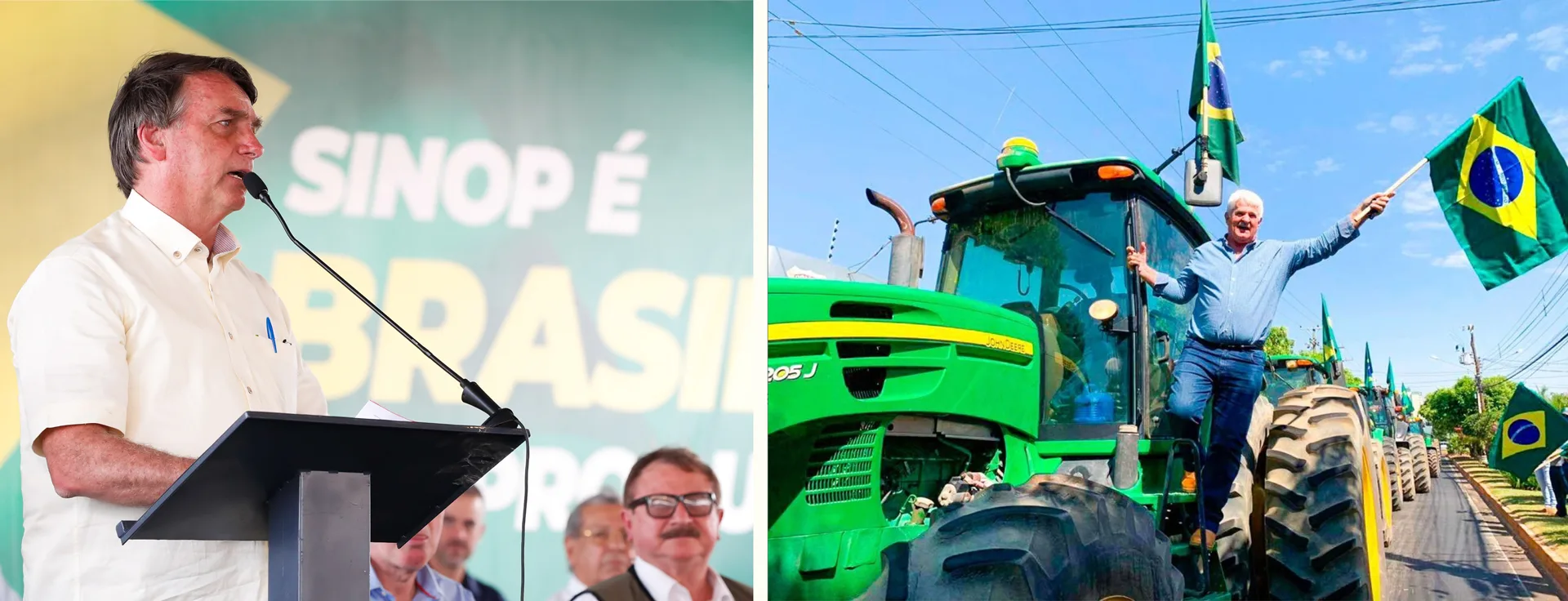
Nabhan Garcia (wearing glasses) and soybean grower Antonio Galvan (at right) are part of the most extremist group of ruralists supporting former president Bolsonaro. Photos: Alan Santos/PR and Screenshot
‘Oh, if I get you’
It is the night of Friday, September 13, the eve of Sinop’s 50th anniversary. Dorner’s campaign has organized a rally – at a training center – attended by the state’s governor, Mauro Mendes, and other allied politicians from Mato Grosso. It is the campaign’s first major rally. The football field is packed. Blue and white flags flutter excitedly. The loudspeaker repeats the slogan ‘vote 22.’ Four kilometers away, at the Municipal Stadium, sertanejo musician Michel Teló, known internationally for his song “Ai se eu te pego” (which loosely translates to “Oh, if I get you”), will take the stage in a few hours to celebrate the city’s half century of existence.
Dorner (Liberal Party) invested R$ 2 million in the festivities, which included sertanejo and gospel concerts, a fishing tournament, and a walk along the Teles Pires River. Mirtes, his adversary, tried to use the courts to suspend the celebrations, questioning the legality of free parties held with public funds during elections. The Electoral Court, however, denied her petition.
All kinds of people are in attendance – including a Lula voter who thinks it’s “buffoonery for the people of Sinop to keep lauding acts to overthrow the government,” as Luciene da Costa, 34, told SUMAÚMA. She was with her friends Leide Cavalcanti and Maria Saul, one of whom supports Bolsonaro.
On stage at the political rally, praise is heaped on the city’s economic growth, works to double the lanes on the BR-163 highway between Sinop and Sorriso, the over R$ 350 million invested by the state government in the municipality. “You don’t mess with a winning team, you go faster. May God bless this campaign,” says Mato Grosso governor Mauro Mendes, while praising Dorner’s term in office. The mayor-candidate takes the stage next and speaks for a quick ten minutes.
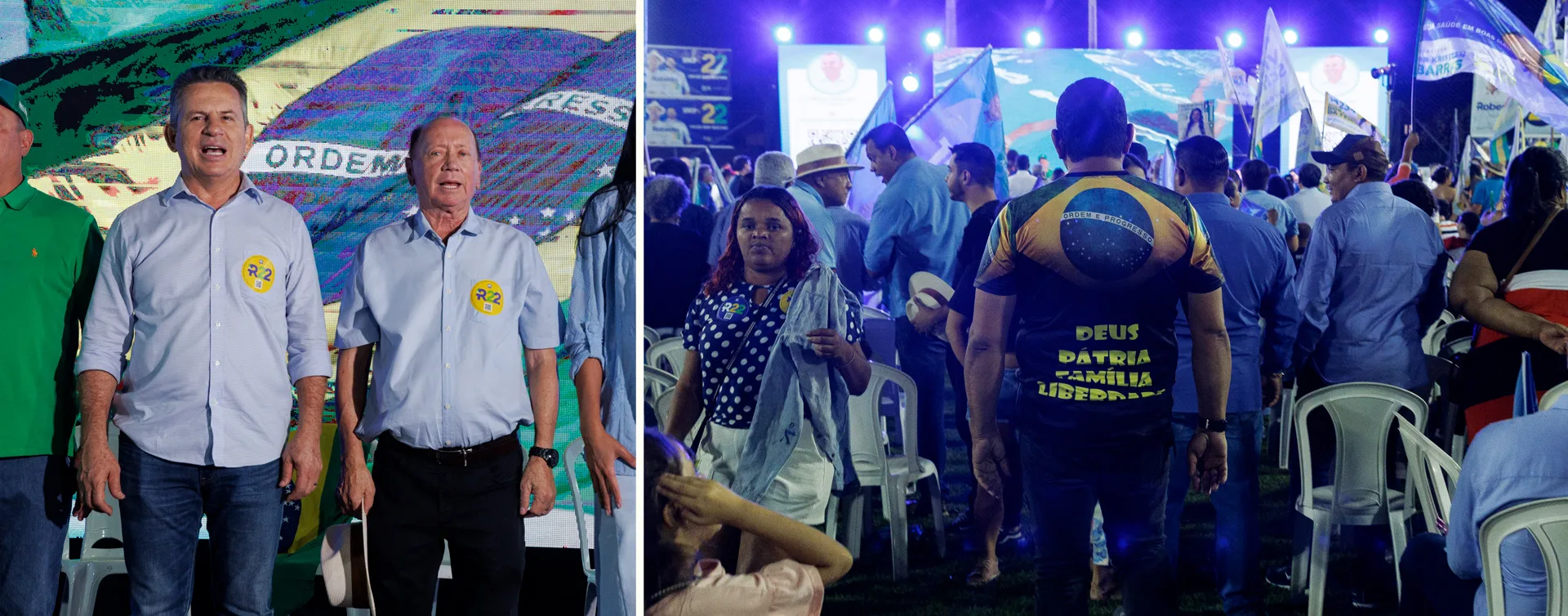
Governor Mauro Mendes supports the incumbent, Roberto Dorner (Liberal Party), who switched to Bolsonaro’s party to gain his support, which he did not get
“I wanted to talk about [public] works, but we’re all tired…. Everyone knows how many [public] works we’ve done in Sinop, we have 14 paved points in the city.” He wears a straw hat, a hallmark of his dress, which has led his opposition to call him the “old man in the hat.”
The smoke everyone breathes and the drought that drags on and on – impacting ag and bringing in lower soybean yields – are ignored in speeches. Yet in the government’s plan, Dorner dedicates a page to the “environmental” issue, where he argues for a city that is “greener, more sustainable and better prepared for the future, where the environment is a priority and an asset to be protected.” The word “deforestation” does not, however, show up.
This word is also not part of the plan under a Mirtes administration. The night before, she had held a walk in Jardim América, a neighborhood on the city’s outskirts. Between two to three hundred supporters were waiting for the candidate to arrive. Her campaign color is also blue, just like her adversary. Mirtes, like Dorner, did not respond to SUMAÚMA’s requests for an interview.
If the campaign had failed to make itself seen on Sinop’s broad avenues, the same could not be said for the followers of Mirtes’s WhatsApp channel – 1,469 messages in 5 days – or of both candidates’ Instagrams. Among photographs, videos, and a variety of posts, one is especially eye-catching: a highly produced photograph of Mirtes in front of a shooting range in the city. A few days later, Dorner shot back. He posted a video inside of Patriotas, one of the five shooting ranges in Sinop, whose façade is made of mirrored glass.
Incompatible models
It is hard for Marciano Silva to breathe. He speaks slowly and takes breaks to catch his breath. He puts his hand on his chest, he seems worried. He’s not sure whether the weight on his lungs is directly related to the perennial smoke on the horizon or if it is something more serious. “I’m going to see the doctor tomorrow, let’s see what they say. I think what I have is [related to] nerves,” says the 46-year-old farmer. He asks that the interview be limited to talking about production, agroecology and good things, because when he talks about problems, he receives threats.
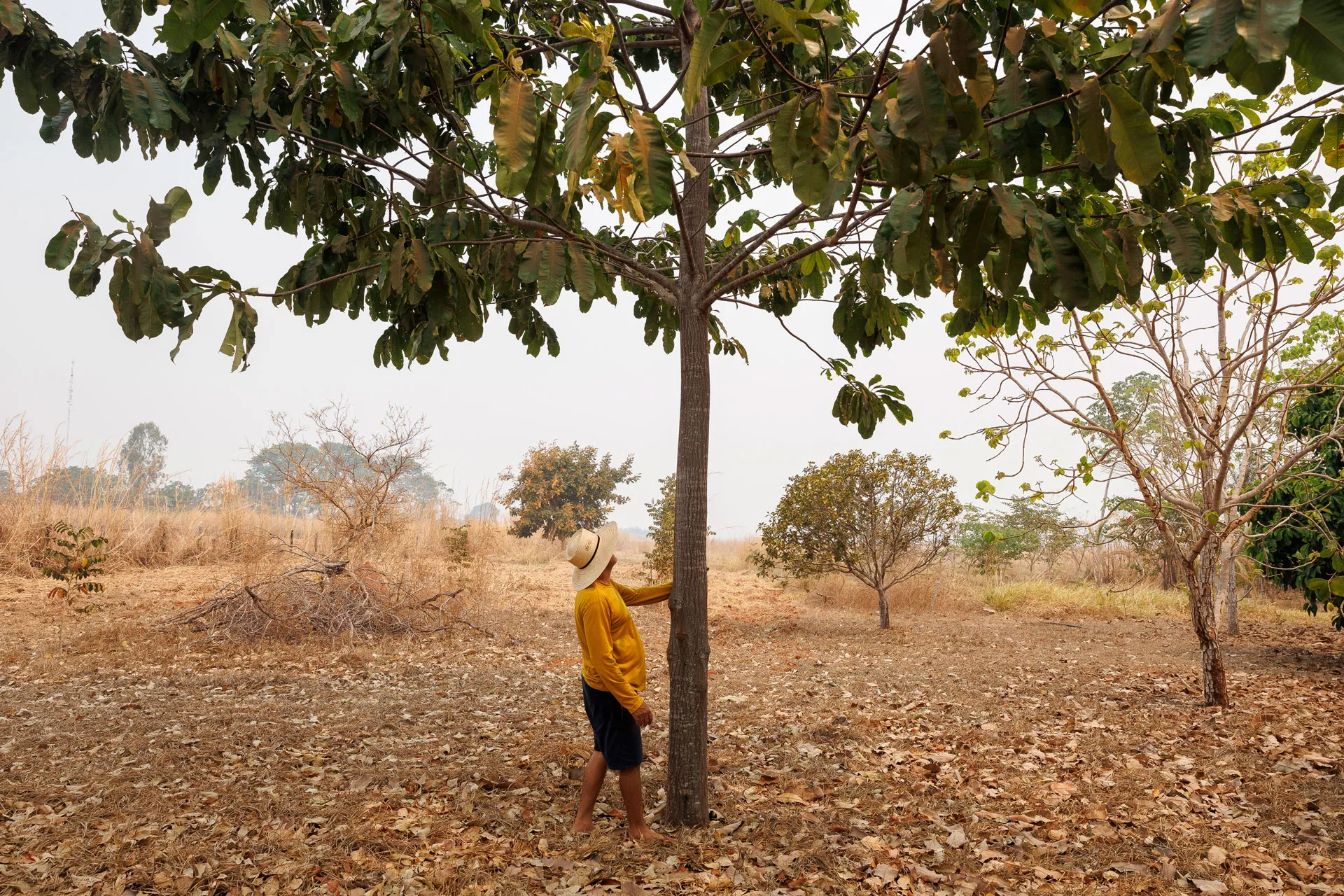
Marciano Silva and his colleagues in the 12 de Outubro settlement are adept at agroecology, a production model that is in opposition to monocultures and agrochemical usage
Marciano is one of the first people to live in the 12 de Outubro Sustainable Development Project, an agrarian reform settlement given regular legal status by Brazil’s agrarian reform agency, Incra, after a group of workers connected to the Landless Rural Workers’ Movement had, in 2006, occupied a farm long left fallow in the municipality of Cláudia, near Sinop.
He, like some of his neighbors, is dedicated to agroecology. He plants tomatoes, lettuce, arugula, parsley, and a variety of legumes and fruits using sustainable thinking, applying no agrochemicals and using everything the territory itself has to offer. Crops are sold in Sinop on Saturdays at the Cantasol project, which helps sell their produce in the city; they also rely on support from the Gaia project, which for five years has trained family farmers on enhanced agroecology techniques.
“Few are able to hold out,” says Marciano about agroecological production, while also referring to the struggle of managing to build a life in a settlement with no government support. He now has a brick-and-mortar home, but everything he has was achieved through the work he and his wife, Teca, have done, since they could never get credit to plant or build. Marciano compares the two models, agribusiness to agroecology. “Destroying the environment is part of the nature of agribusiness. Large landholders are very selfish. The environment is just an instrument, a resource. We [human beings] are part of Nature and [are] the least important part of Nature. Nature, with us, is hurt, injured and subjected to death every day. Without us, it lives marvelously well.”
He shows off his garden with pride. “I get R$ 2,100 a month from it.” On his land, all the trees, including a squat young chestnut tree, were planted by him. “When we arrived here, only 45% of the farm’s area was a reserve [of preserved land],” he recalls. The first residents were tasked with restoring the forest in some areas and caring for the old-growth forest – which was designated as a collective area.
Yet today the settlement is even more deforested. At the entrance, near the BR-163 highway, there is a large area with towering chestnut trees – but practically no forest around. “It used to be all woods,” Marciano says. While near the town, where there is a school, a health post, and a building materials shop, one piece of land was recently burned. A little bit of visible forest area lies in the back, near the river. A sign next to the school is advertising land for sale. A few meters away, a closed gate reads: “Lagoa Dourada Farms – restricted access.”
Land-grabbing is even more prevalent in the settlement since the Sinop Hydroelectric Plant flooded part of the forest, dammed the Teles Pires River, and created a reservoir next to the settlement, in 2019. Near the “flooded” area, as the residents call the reservoir, roads have been built, homes are under construction, and areas have recently been deforested. This activity is illegal, since this is an area belonging to Brazil’s agrarian reform agency, Incra, that was granted to farmers. Sinop’s social movements have complained to the competent authorities – with no effective results so far. Sinop Energia, which runs the hydroelectric plant, says the area is under Incra’s responsibility, but that the reports “made by the company resulted in actions by the authorities such as oversight by the Environmental Military Police and the opening of an inquiry by the Federal Police.” Asked to comment, Incra said it inspected the location in June 2023 with the aim of “contributing to processes to remove invaders from the legal reserve area,” which are currently in the administrative phase.
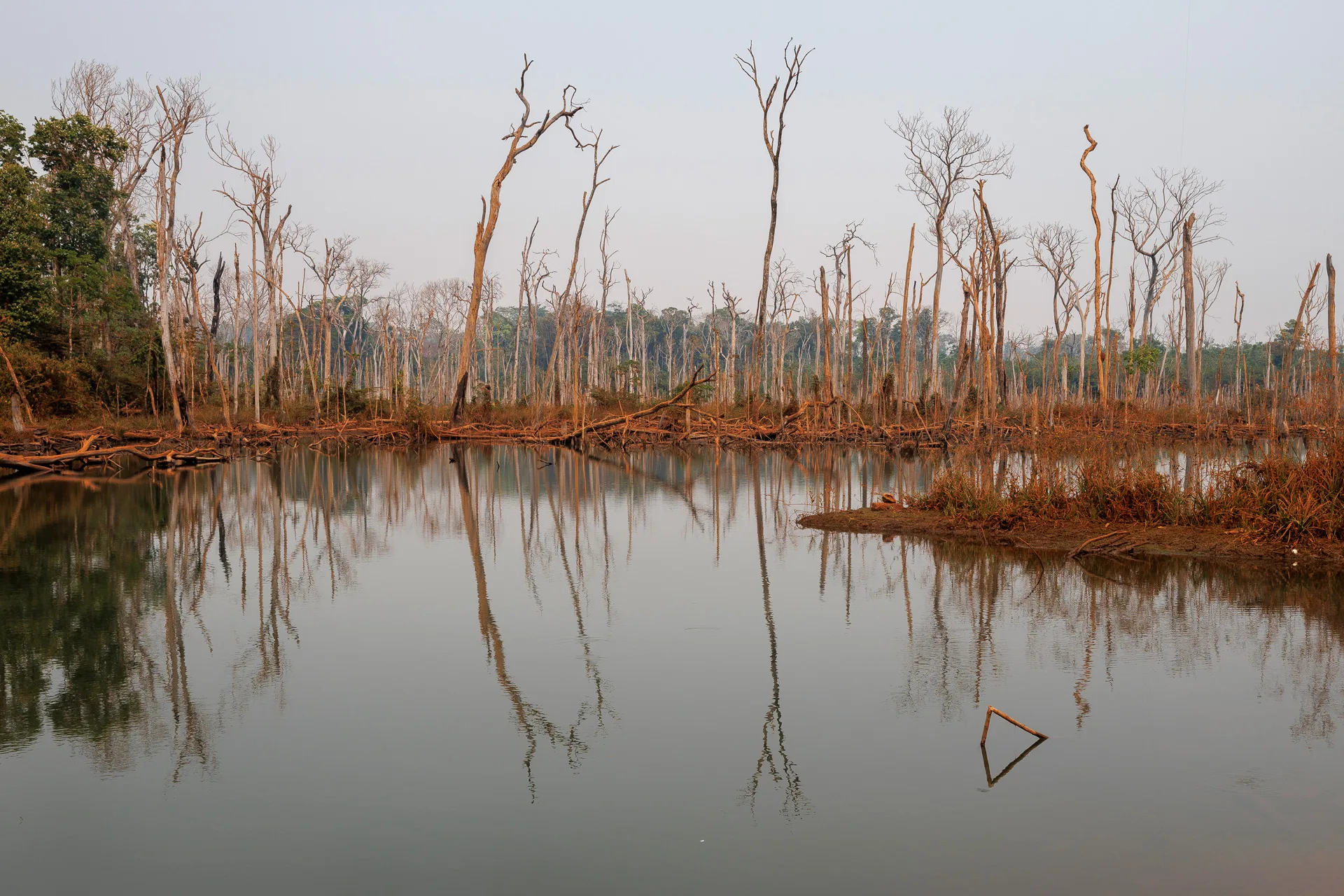
Beyond deforestation and the impact of monoculture, the city has a hydroelectric plant that has sequestered the river water and made cemeteries out of trees
The reservoir forced some 100 of the originally settled families to leave the 12 de Outubro settlement and it is now forcing them to deal with land-grabbers. There were also settlements that sold their lands to cattle and soybean farmers. This brings yet another problem to the smallholders: agrochemicals.
Calixto Crispim and his wife Alessandra lived next to a soybean farm for a few years – inside the settlement. When she was pregnant, they were forced to spend some days in a different house. “This guy sprayed poison five times for each bag of soybeans, plus five for each bag of corn. The wind was blowing toward our home. And then my wife inhaled this stuff… and she started to feel nauseous. Her belly was this big. What anxiety!” says Calixto. “My son is autistic. I can’t prove that his disorder was caused by agrochemical use. But there are studies pointing to an outrageous rise in cases of autism spectrum disorder, largely because of bad diet and poisoning.”
Calixto is a tall black man with a big and frequent smile, even when he is talking about sad things. Like his neighbor and brother-in-law Marciano, he has an agroecological garden and sells his produce in Sinop. There are several different types of trees on the current land – pitomba, nance, cashew. They also keep stingless Jataí bees. Outside of his crop area, he is a school teacher in the settlement.
He says that the deforestation and land-grabbing began in 12 de Outubro in 2015, but grew much worse under the Bolsonaro administration. Calixto avoids talking about the problems and conflicts he has had with the invaders. He limits himself to saying that he “almost got sick.”

Teacher and farmer Calixto Crispim proudly shows his beehive and his agroecological garden – his products are sold in Sinop
Agro-suicide
“A harvest to forget.” This was the title of an article published by the Brazilian Association of Soybean Growers, the industry’s biggest trade group, and published in May that predicted the soybean crop would fall by 21% in the state of Mato Grosso this year. Even if the tone and percentage are exaggerated, the organization wasn’t wrong. Data published on September 12 by Brazil’s National Supply Company estimates that the 2023/2024 harvest will bring in 147 metric tons, 4.7% less than the last harvest, of 154 million metric tons. The impact was greater in Mato Grosso: production fell by nearly 13.7% (from 45.6 million metric tons to 39.3 million for this harvest). And the harvest in Sinop shrunk by 9.3% (going from 678,427 metric tons in the last harvest to 615,483 metric tons for this one), according to a survey by the Mato Grosso Institute of Agricultural Economics.
“The decline seen is mostly due to the delayed start of rains, low precipitation, and high temperatures in areas sown between September and November,” reads the statement from the National Supply Company. The legume is supposed to be planted between September and November – a period when the Amazon was facing its worst drought in recent years – while excessive rain drenched Rio Grande do Sul.
Farmers usually react to decreased production or to drought by expanding their crop area – and the numbers bear this out. During this harvest, the area used for soybeans grew by 4.4%, yet productivity fell by another 8.7%.
Forest engineer Argemiro Teixeira Leite-Filho, a researcher at the Remote Sensing Center at the Federal University of Minas Gerais, says that increasing crop area is another “shot in the foot.” Actually, it might be a shot in the heart, because the scenario is so delicate that Argemiro has coined a self-explanatory term for the phenomenon of Brazilian agribusiness: agro-suicide. Since 2016, he has been looking at the relationship between deforestation, rain, and agricultural production. And it would be limiting to say the relationship is direct: the greater the deforestation, the greater the decline in rainfall and the greater the drop in agricultural production.
“From 1999 to 2019, widely deforested regions showed an approximately 76-day delay to the start of the rainy season. These regions also have 360 millimeters less precipitation and a maximum air temperature that is 2.5ºC hotter,” reads a passage from a paper he published in January of this year.
Another interesting conclusion from his studies is confirmation that local deforestation also impacts territorial rains. In other words, it isn’t just the deforestation in southern Amazonas state that is affecting the rain in Mato Grosso – the state’s own deforestation is causing less rain to fall on its crops. “Conservation [of the forest] is fundamental to agricultural production,” he says.
Argemiro spent a few months interviewing farmers in Pará. He notes that, although the farmers find it hard to recognize the climate emergency, they are adopting adaptive measures, such as increasing their crop areas, sourcing better seeds, or taking out credit for irrigation. Yet for the researcher, “seeing the native vegetation as part of production is as important as the producer thinking that next year they’re going to have to buy enhanced seeds.” This is also a cheaper measure to maintain high yields on their lands.

After deforesting 205,000 hectares of forest from 1987 to 2023, few preserved areas are left, like the banks of the Teles Pires River
The occupation that has no name
Alexsandra de Sousa Silva shows the herbs she is planting in her home – aloe vera, basil, lemon grass – and she complains of the dryness and heat. “People say the coming of Jesus is near, but no it isn’t; it’s humans actually who are destroying nature, destroying everything.” She is one of the few residents in the occupation with no name that sits on the urban outskirts of Sinop whose house has a tile floor. Her neighbors have wooden houses with dirt floors.
With no name to use, she calls the neighborhood “cricket.” Its streets unpaved, with no regular electricity and no sewerage, it sits in front of a soybean field and next to the Jardim Araguaia neighborhood.
When she came to Sinop five years ago, Alexsandra was employed as a domestic worker in the Aquarela neighborhood. Now, she cares for her own house. Her husband and one of her kids, who is 17, work in construction. She was born in Floriano, Piauí, and grew up in Paraupebas, Pará. And despite living in one of Mato Grosso’s wealthiest cities, which produces 615,000 metric tons of soybeans annually, Alexsandra says that “all I wanted was some money to buy dinner.”
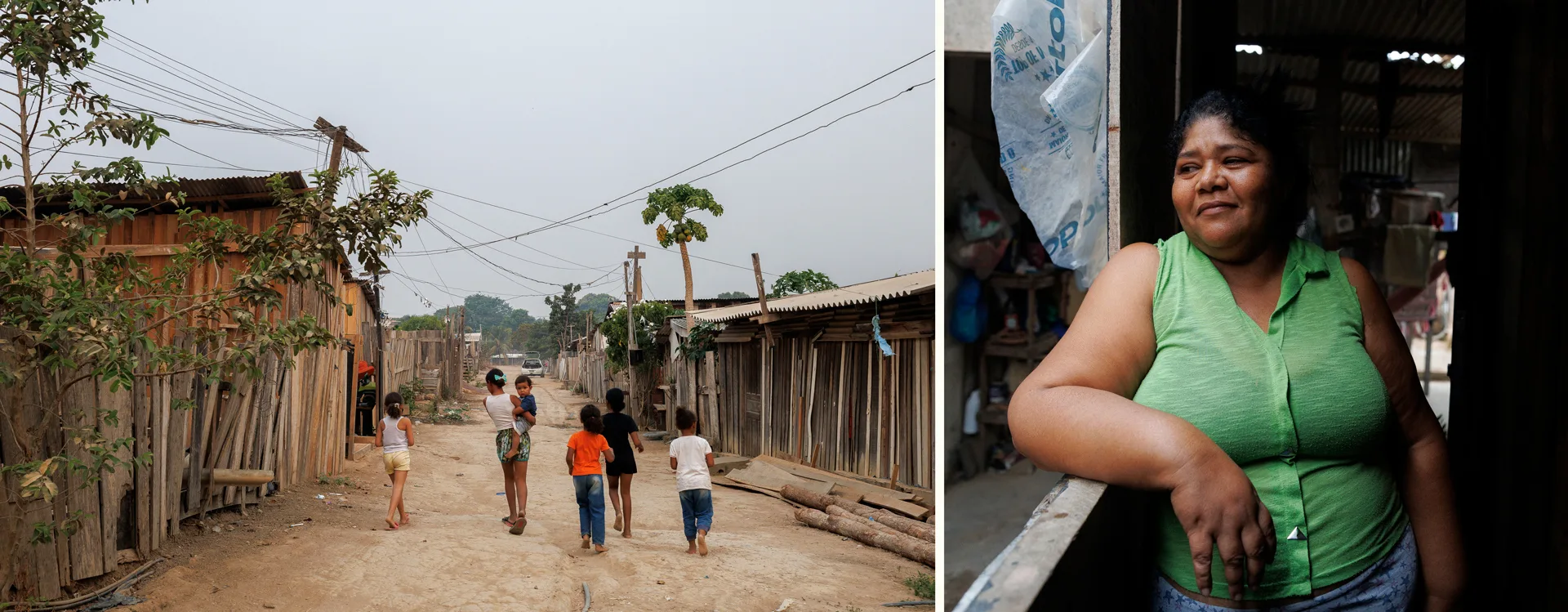
Alexandra de Sousa says she loves Sinop, despite living in an occupation with no sewerage and no name on the edge of the city
She says her husband is waiting to receive R$ 6,000, and his boss won’t pay. He waits. Each day an eternity. But she doesn’t get upset – and she doesn’t complain. She just says she thinks it’s a waste for the mayor to spend R$ 2 million on a party. “He should be taking care of people in need.” Alexsandra has no candidate for election day. “When we need it, nobody helps.”
From the metal structures assembled on the main avenue for the September 7 celebrations, now sitting unused, you have to squint to see the outline of the Metropolitan Cathedral in the background. The horizon is dominated by what seems to be a thick fog, but the air is heavy when you breathe in, scratching your throat and making you hack. The fires that affected most of the country early in September have also surrounded the city. It smells of smoke mixed with must, the sweetly fermented smell of corn, used to feed the region’s ethanol plants.
There are already signs of the apocalyptic future.
Yet deep down, the landscape interspersed with chunks of primary forest insists on remembering that Sinop is also the Amazon. And survival is only possible with the forest.
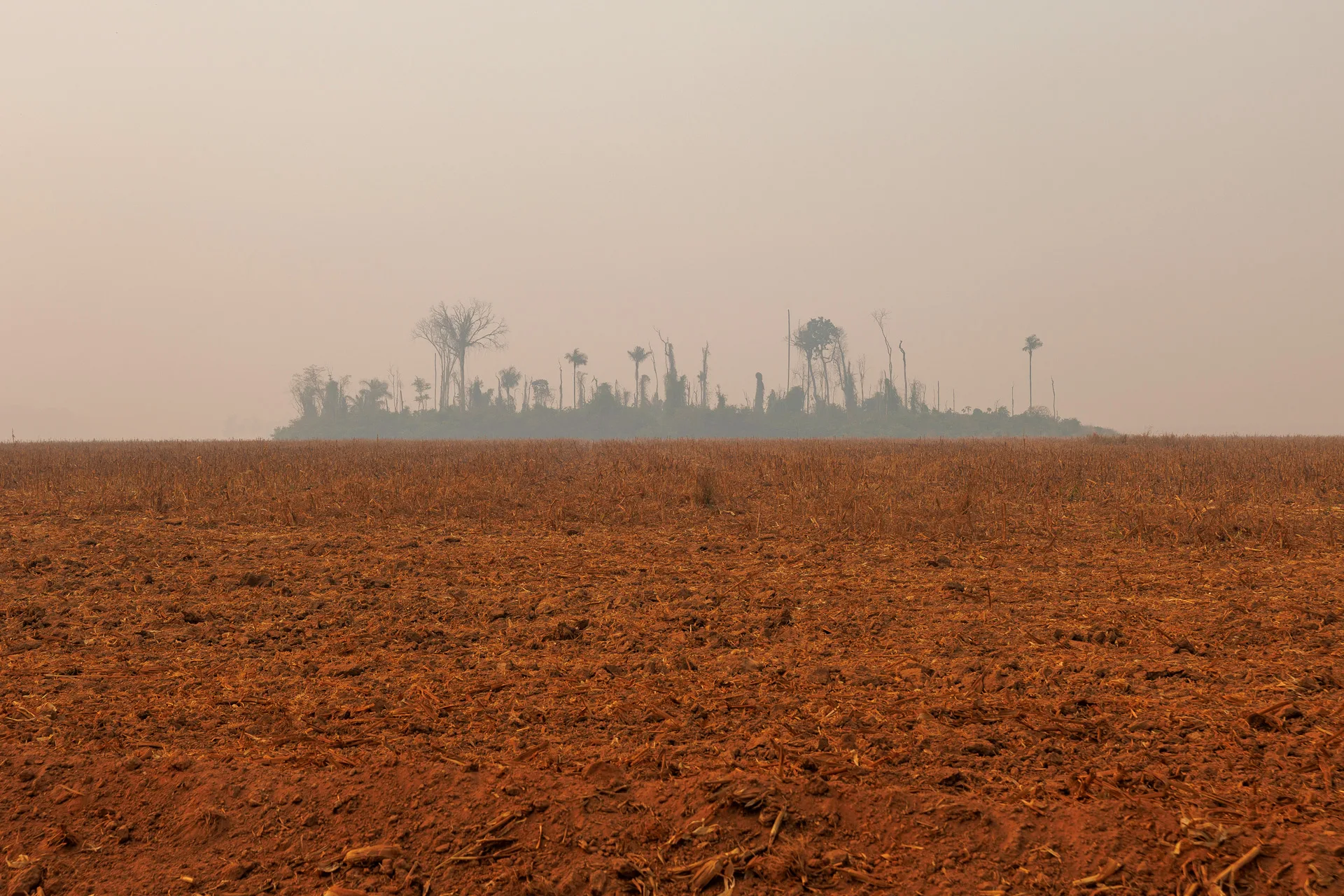
Amidst the dryness and smoke, a forest “island” insists on serving as a reminder that all of this is the Amazon
Report and text: Ana Magalhães
Editing:Talita Bedinelli
Photo Editor: Lela Beltrão
Fact-checker: Gustavo Queiroz
Proofreader (Portuguese): Valquíria Della Pozza
English translation: Sarah J. Johnson
Spanish translation: Julieta Sueldo Boedo
Copyediting and finishing: Natália Chagas
Editorial workflow coordination: Viviane Zandonadi
Editor-in-chief: Talita Bedinelli
Editorial director: Eliane Brum





